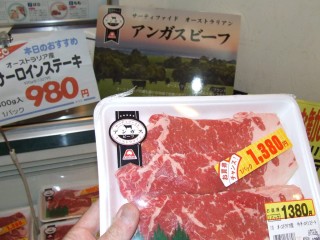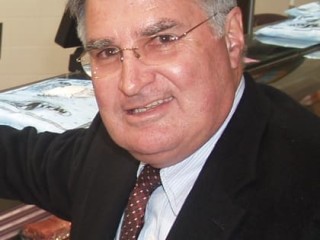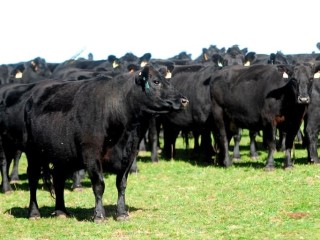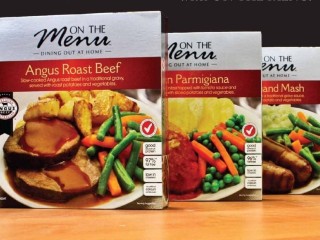 Fifteen years after its launch as one of the nation’s pioneer commercial beef brands, Certified Australian Angus Beef continues to set benchmarks by which other brand programs can be measured.
Fifteen years after its launch as one of the nation’s pioneer commercial beef brands, Certified Australian Angus Beef continues to set benchmarks by which other brand programs can be measured.
CAAB celebrated its 15-year milestone with a six-course dinner showcasing different interpretations of its product at Sydney’s Kingsley’s restaurant last Thursday night.
In the audience was a range of supply chain stakeholders including certified processors, distributors, food editors and food bloggers, including Simon Leong, who wrote this account, together with photos.
From the most humble of origins, CAAB has grown to become the largest and arguably one of the most successful brands in the country.
Annual throughput of more than 100,000 cattle is about 30 percent larger than the nation’s second largest brand program, the Australian Agricultural Company’s 1824 brand which last year accounted for about 70,000 company cattle.
While CAAB’s establishment in 1996 certainly took some of its cues from the US Certified Angus Beef program (see separate references) it is far from a ‘mirror image’ brand and charted its own course from the outset.
CAAB chief executive Phil Morley said while there were some similarities between the Australian and US Angus brand models, the trading environments in the two countries were very different.
“CAB has about 12,800 customers using the brand, and utilises multiple processors across the US, but the great majority of their product is sold domestically,” he said.
“Nor do they have the type of supermarket structure we have in Australia, with two big powerful players."
"CAB supplies an enormous amount of product in to US supermarkets, which are happy to carry and promote CAB as a brand, because the more fragmented nature of the US retail industry means they are not strong enough to rely solely on their own in-house brands. In Australia, dominant Coles and Woolworths are keen to promote only their own brands, so it is a very different environment,” Mr Morley said.
He told Thursday's anniversary dinner audience it would have been difficult to foresee CAAB making the progress it had, when the program first started back in 1996.
While the program’s traded volumes for year-to-date 2011 were slightly down on same period last year, this was in the face of a very tough global and domestic trading environment, and the 2010 year itself was ‘exceptional’, being 37 percent up in volume on the previous year, Mr Morley said.
“Apart from the understandable minor hiccup this year, CAAB has been on an ever-increasing growth path for more than a decade,” he said.
Another contributing factor had been the loss of domestic business in both Coles and Woolworths supermarkets, which had occurred solely for ‘competitive retail positioning reasons,’ rather than anything to do with product performance or popularity.
Both CAAB and AA Co’s 1824 brand no longer appear in major supermarket shelves. CAAB was at one point stocked in about 90 Coles and 170 Woolworths stores.
The decision by Coles to focus instead on its own premium brands (Coles Finest 100-day product, generated out of the Maconochie family’s Hopkins River feedlot in Victoria and processed at JBS Australia's Brooklyn plant; and Rangers Valley feedlot near Glen Innes processed at the Australian Country Choice plant in Brisbane) saw 100,000kg/month of CAAB beef and sausages having to find alternate homes.
“We remain receptive to having a CAAB presence in supermarket shelves, whether it is one of the majors, or smaller chains, but it is not a do-or-die for us,” Mr Morley said.
“It would have to be under the right circumstances, because this is a premium product, and it has always been presented that way.”
As has been seen across the Australian high-quality grainfed export beef industry recently due to currency and economic issues, CAAB has also suffered a minor setback in export markets this year.
Partly offsetting those challenges has been solid growth in the food service sector in Australia, and some new overseas business.
“It has certainly found its niche in a growing number of higher-quality restaurants and hotels, as well as gourmet, up-market butchers. That really seems to be the niche for the CAAB brand in the domestic trade,” Mr Morley said.
Overseas, export trade continues to grow through strong customers like the large Lotte-Mart supermarket chain in Korea, and customers in Japan via the Teys-Cargill joint venture.
‘Angus’ name’s popularity in brands
 So has the emergence of other Australian brands bearing the descriptor, ‘Angus’ diluted the strength of the CAAB name?
So has the emergence of other Australian brands bearing the descriptor, ‘Angus’ diluted the strength of the CAAB name?
“Any time there is another ‘Angus’ brand, whether that be our own Angus Pure no HGP/pasturefed program, or a Teys Black Angus or something else, it can have an impact, but the overall penetration of Angus-derived brands has been very pleasing,” Mr Morley said.
The company’s decision to launch its own Angus Pure program had helped ‘grow the pie’ for Angus beef generally, and now accounted for 15-20 percent of all CAAB business turnover.
“While my primary role is to drive the CAAB brand, all the exercises the breed has done with McDonald’s and Patties Pies and others in driving a certified Angus program has inevitably enhanced the popularity and recognition of Angus beef, and cattle,” Mr Morley said.
“While Angus-derived brands have had some level of impact on CAAB, as one would quite rightly expect, as a company owned by Angus Australia and its 3000-odd producer members, brand competition has been absolutely fantastic for the Angus cattle producer.”
“However my biggest concern is that that if we are going to do business in a competitive marketplace environment, it must be against brands that have integrity within their claims. It’s why we have got involved in doing breed verification for other brands,” he said.
Verification and integrity was one of the platforms on which CAAB had been built, and continued to underpin its success in the marketplace.
The licensing, certification and monitoring process is applied at every point in the production chain to underpin product, brand and trademark integrity. Licensees include cattle suppliers, feedlots, processors, portion-controllers, value-added product manufacturers, wholesalers/distributors, retailers and food service outlets.
All cattle are individually identified and can be tracked throughout the production process, using Pfizer Animal Genetics’ Suretrak DNA sampling and testing technology, ensuring the highest product integrity and enabling information feedback at all points.
On the verification side – both for CAAB and various other brand programs like McDonald's Angus offer – the sole focus is not on issues like quality, cipher or description, but on verifying that the product sold was in fact derived from Angus animals. The Suretrak process is also used for random breed content verification in this area.
Unlike the US CAB program that requires only 50pc Angus (black) genetics, CAAB accepts only animals that can be verified as sired by Angus bulls and calved out of straightbred Angus or black baldy dams. This delivers an absolute minimum of three-quarter breed content, but most were in fact straightbreds.
Genetic improvement delivers efficiency
 Mr Morley said over time, genetic improvement had driven better performance in cattle in meeting CAAB’s specifications, including minimum marbling score of 1+.
Mr Morley said over time, genetic improvement had driven better performance in cattle in meeting CAAB’s specifications, including minimum marbling score of 1+.
“Certainly there would be more cattle making CAAB marbling requirements with more consistency today than ten years ago, and often using fewer days on feed,” he said.
“The emphasis has been in the more efficient feeding period delivering an as-good or better product in the box, rather than an attempt to significantly lift in overall marbling result, where the impact of genetic improvement is being seen,” he said.
“But certainly the genetic improvement being driven by the Angus industry’s heavy emphasis on objective traits measurement has been a big asset to the CAAB program.”
While the minimum feeding requirement was 100 days, most CAAB cattle were in fact fed about 120-140 days and some licensed feedlots fed cattle out to 180 days for specific customer requirements in Japan.
In spite of the great brand success story it has been over the past 15 years, Mr Morley said there was still enormous scope to take the brand to new customers, both in in existing and emerging markets in Australia and overseas.
“We are really keen to move forward with our processor partners in that area. To suggest CAAB has reached saturation point in Japan, for example, is far from the truth. There are big populations in Asia with lots of opportunities, and in many we are still only scratching the surface, even in mature markets like Japan.”
Value-adding opportunities emerging
 Increasingly, CAAB was also seeking business partners who wanted to value-add beef products, using the CAAB identity as part of a brand.
Increasingly, CAAB was also seeking business partners who wanted to value-add beef products, using the CAAB identity as part of a brand.
A good example was Perth-based value-adding company, Vesco Foods, which had developed a high-quality pre-cooked heat-and-serve frozen meal product carrying the CAAB identity, retailed through Coles and Woolworths.
The raw material used is cap-off, denuded topside, producing a slow-cooked roast beef in traditional gravy, served with roast potatoes and vegetables, under the brand name “On the Menu”.
“It’s a fabulous product which is performing very well on supermarket shelves, and we see lots of opportunity to expand in this area,” Mr Morley said.
-
See upcoming comments from another speaker at CAAB’s fifteenth anniversary dinner, cattle supplier, Susie Chisholm.
